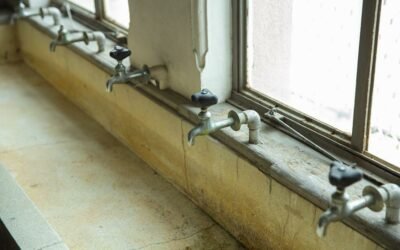Do you know if algae is mold?
In this article, we will explore the differences between algae and mold, their characteristics, and the environmental factors that contribute to their growth.
We will also discuss the potential health effects of exposure to algae and mold and provide tips on how to prevent and control their presence.
So, let's dive into the scientific world of algae and mold to gain a better understanding of these organisms.
Key Takeaways
- Algae and mold belong to different biological classifications, with algae being photosynthetic organisms and mold being a group of fungi.
- Algae can produce their own food through photosynthesis, while mold relies on organic matter for nutrition.
- Algae can range in color from green to golden, while mold appears as fuzzy or powdery growth and can be black, green, or white.
- Algae play a crucial role as primary producers in aquatic ecosystems, providing food and oxygen for other organisms, while mold primarily functions as decomposers, breaking down organic matter.
Algae Vs Mold: Understanding the Differences
To understand the differences between algae and mold, you need to start by examining their characteristics and behaviors.
Algae and mold are both types of microorganisms, but they belong to different biological classifications. Algae are a diverse group of photosynthetic organisms that can be found in various environments, including freshwater, saltwater, and soil. They're capable of producing their own food through photosynthesis, using sunlight and carbon dioxide.
On the other hand, mold refers to a group of fungi that thrive in damp and humid conditions. Unlike algae, mold can't carry out photosynthesis and relies on organic matter for nutrition. Mold spores are microscopic and can easily be dispersed through the air, leading to the growth of mold colonies on surfaces such as walls, ceilings, and food items.
In terms of appearance, algae can range from single-celled organisms to complex multicellular structures. They can be green, red, brown, or even golden in color. Mold, on the other hand, appears as fuzzy or powdery growth and can be black, green, or white. Mold colonies often have a musty odor.
Additionally, algae and mold have different ecological roles. Algae play a crucial role in aquatic ecosystems as they're primary producers, providing food and oxygen for other organisms. Mold, however, is often associated with decay and can cause damage to buildings, food, and even human health.
Characteristics of Algae and Mold
Now let's delve into the characteristics of algae and mold. Algae and mold may appear similar at first glance, but they possess distinct characteristics that set them apart. Here are three key features that differentiate algae from mold:
- Cellular Structure: Algae are single-celled or multicellular organisms that contain chloroplasts, enabling them to carry out photosynthesis. They've a diverse range of shapes, from filamentous to spherical, and can be found in various aquatic environments, including freshwater, marine, and even damp soil.
In contrast, mold belongs to the fungi kingdom and consists of multicellular filaments called hyphae. Mold colonies often appear fuzzy or powdery and thrive in moist environments, such as bathrooms, basements, and areas with water damage.
- Reproduction: Algae reproduce through various means, including fragmentation, asexual reproduction, and sexual reproduction. Some algae species can produce spores or form specialized structures called gametangia for sexual reproduction.
On the other hand, mold reproduces by releasing spores into the air, which can then settle on suitable surfaces and germinate under favorable conditions. This spore-based reproduction allows mold to spread rapidly and establish new colonies.
- Ecological Role: Algae play a crucial role in aquatic ecosystems as primary producers, providing food and oxygen for other organisms. They also contribute to the global carbon cycle by absorbing carbon dioxide through photosynthesis.
In contrast, mold primarily functions as decomposers, breaking down organic matter and recycling nutrients. While some molds can be beneficial in biotechnological applications, others pose health risks and cause damage to buildings and materials.
Understanding these distinctive characteristics is vital for accurately identifying and managing algae and mold in various environments.
Environmental Factors for Algae and Mold Growth
When it comes to the growth of algae and mold, understanding the environmental factors is crucial. These factors play a significant role in determining whether algae or mold will thrive in a particular environment. Let's take a closer look at some of the key environmental factors that affect their growth.
| Environmental Factors | Algae Growth | Mold Growth |
|---|---|---|
| Light | Requires light for photosynthesis. Algae thrive in areas with ample sunlight. | Thrives in dark and damp environments. Excessive light can inhibit mold growth. |
| Moisture | Requires a moist environment for growth. Algae can tolerate high levels of moisture. | Flourishes in damp and humid conditions. Mold growth is favored by moisture levels above 50%. |
| Temperature | Prefers warm temperatures between 68°F and 86°F. | Thrives in a wide range of temperatures, but prefers temperatures between 70°F and 90°F. |
| Nutrients | Requires nutrients like nitrogen and phosphorus for growth. | Can grow on a variety of organic materials, including wood, paper, and fabric. |
| Air Flow | Thrives in stagnant or slow-moving water. | Flourishes in areas with poor air circulation. |
Health Effects of Algae and Mold Exposure
Exposure to algae and mold can have detrimental effects on your health due to the release of airborne spores and toxins. When you come into contact with these harmful substances, they can affect your respiratory system, skin, and overall well-being. Here are three specific health effects to be aware of:
- Respiratory issues: Inhaling airborne spores and toxins from algae and mold can lead to respiratory problems such as coughing, wheezing, and shortness of breath. These symptoms can be especially severe for individuals with pre-existing respiratory conditions such as asthma or allergies.
- Skin irritation: Direct contact with algae and mold can cause skin irritation, itching, and redness. This is particularly common in individuals with sensitive skin or those who've prolonged exposure to contaminated surfaces or water.
- Allergic reactions: Some people may develop allergic reactions when exposed to algae and mold. Common symptoms include sneezing, nasal congestion, itchy eyes, and a runny nose. These reactions can vary in severity depending on individual sensitivity and the amount of exposure.
It is important to take necessary precautions to minimize your exposure to algae and mold, especially in environments where they're known to thrive. Regular cleaning, proper ventilation, and maintaining optimal humidity levels can help reduce the risk of health issues associated with these substances. If you suspect a significant algae or mold problem in your living or working space, it's advisable to seek professional assistance for proper remediation.
How to Prevent and Control Algae and Mold
Are you wondering how to prevent and control the growth of algae and mold? It's essential to take proactive measures to prevent their proliferation.
One way to accomplish this is by controlling moisture levels in your environment. Algae and mold thrive in damp conditions, so it's crucial to keep humidity levels below 50%. You can achieve this by using dehumidifiers or air conditioners. Additionally, ensure proper ventilation in areas prone to moisture, such as bathrooms and kitchens, to minimize the accumulation of moisture.
Regular cleaning and maintenance are also vital in preventing the growth of algae and mold. Clean surfaces regularly with a mild detergent and water solution. Pay extra attention to areas with visible signs of algae or mold, such as shower curtains, tiles, and windowsills. Promptly repair any leaks or water damage to prevent moisture build-up.
To further prevent algae and mold growth, ensure proper drainage around your property. Make sure gutters and downspouts are clear and functioning correctly. Avoid excessive watering of plants near your home, as excess moisture can contribute to the growth of algae and mold.
In outdoor spaces, it's advisable to trim trees and plants to allow sunlight to reach the ground, as sunlight inhibits the growth of algae and mold. Additionally, regularly clear away any organic debris, such as fallen leaves or grass clippings, which can provide a suitable environment for their growth.
Conclusion
In conclusion, it's important to understand the differences between algae and mold due to their distinct characteristics, growth requirements, and potential health effects.
Algae are photosynthetic organisms found in aquatic environments, while mold refers to various types of fungi that thrive in damp and dark conditions.
Both algae and mold can cause respiratory issues and allergic reactions in humans.
Implementing preventive measures and effective control strategies is crucial to mitigate the growth and spread of algae and mold in order to maintain a healthy environment.





0 Comments